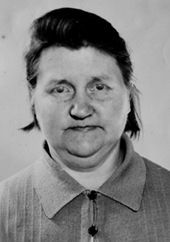Search for Names, Places and Biographies
Already layed Stumbling Stones
Suche
Anna Bollhagen * 1892
Bäckerbreitergang ggü. Haus Nr. 12 (Hamburg-Mitte, Neustadt)
HIER WOHNTE
ANNA BOLLHAGEN
JG. 1892
EINGEWIESEN 1943
LANDESHEILANSTALT
MESERITZ-OBRAWALDE
ERMORDET 26.7.1943
Anna Bertha Marie Bollhagen, b. 8.22.1892 in Hamburg, committed on 7.30.1935 to the then Alsterdorf Institute, transferred on 4.9.1943 from the Langenhorn State Mental Hospital to the Meseritz-Obrawalde State Mental Hospital, murdered 7.26.1943
Bäckerbreitergang opposite House no. 12 (Bäckerbreitergang 59a)
Anna Bollhagen was born the third youngest of a total of eight children in her parental home at Bäckerbreitergang 59a. Her parents, the postal official Carl Wilhelm Johann Bollhagen (b. 5.3.1854) and Henriette Friederike Dorothea, née Vesper (b. 9.21.1867), were married on 6 May 1887 in the Lütgendorf Church in Mecklenburg-Schwerin. Anna’s younger brother Carl Friedrich Albert (b. 1.1.1898) did not return from World War I; he died from a wound on 3 September 1918 in English captivity. A sister had already died in her youth.
Anna Bollhagen attended elementary school and received training as a girdle seamstress. She was still living with her parents when, on 11 November 1933, suffering from a "psychosis,” she was sent from the St. Georg Hospital for a six week stay at the former Friedrichsberg State Hospital in Hamburg-Eilbek. A second stay at Friedrichsberg followed on 16 May 1935, this time with a diagnosis of "epilepsy and hallucinations.”
On 30 July of the same year, Anna was accepted in the then Alsterdorf Institute (today the Alsterdorf Evangelical Foundation). She was put in a weaving class where she took pains so that "everything turned out right.” She helped in keeping herself clean without being asked. In the hospital records, Anna was initially described as orderly, always friendly, and content. When she was praised, she was happy. Concerning her epileptic seizures, the caregivers noted from the beginning of her stay: "her convulsions occurred suddenly, out of the blue; as soon as she was able, she continued working, demonstrating will power. She frequently asks: Did I have convulsions?”
In the course of the following eight years, Anna’s epileptic seizures increased in violence and frequency. She was now described as very excitable and irritated, inaccessible and mistrustful.
It can be determined from her hospital records, that in April 1938 alone, she suffered 34 epileptic convulsions. Her personal evaluations were increasingly negative.
When Anna learned from another patient that they were putting Luminal, a tranquilizer, in her food, she gave it away or spilled it. To calm her she also received "wet packing,” that is, she was rolled up in cloths which, when they dried out, contracted painfully.
After several attempts at escape, Anna, a permanent patient, was isolated in a guarded ward and kept in restraints when in bed. The Institute’s directing physician, Gerhard Kreyenberg (see the database: www.hamburg.de/ns-dabeigewesene) judged: "serious alteration of character, the result of epilepsy.” In a notification to the family on 23 February 1943, he wrote: "Unfortunately, the condition of your daughter has so worsened in the last months that her remaining at the Alsterdorf Institute is no longer possible. We feel compelled therefore to transfer her to Langenhorn in the next days.”
Anna Bollhagen was transferred on 9 March 1943, along with a further seven women and girls, to the Langenhorn Sanatorium and Nursing Home. There she was evaluated quite differently: "quiet and unobtrusive, no contact with other patients. Outwardly orderly and independent. Head wound [she had been injured during a convulsion]. Works at sewing.” And just a month later: "wound healing well. Pat[ient] is completely quiet. Will be transferred today to Meseritz.”
Despite the positive evaluation of "completely unobtrusive,” Anna Bollhagen was sent on 9 April 1943 to the Meseritz-Obrawalde State Mental Hospital. Originally built in 1904 as a provincial hospital, "a place of healing,” in Pomerania, it had, after the official halt to the "T-4 Aktion” in August 1941, taken on the function of a killing center, part of the "euthanasia” program.
Selections were carried out by the directing physician of the institution, Theophil Mootz, and the institute physician Hilde Wernicke. The killings were carried out by the caregiving personnel, mostly by an overdose of morphine, scopolamine, veronal, and evipan in so-called isolation chambers. The patients also died from debilitation through starvation. The official registry office reported false death dates from natural causes. As her family was informed in writing after an inquiry in 1955, Anna Bollhagen passed away on 26 July 1943 as the result of "cumulative epileptic seizures.”
Since 2009, a plaque has stood before the Walter-Behrmann-Haus of the Asklepios Klinik Nord-Ochsenzoll, memorializing the deportation of 4097 patients from the former Langenhorn Sanatorium and Nursing Home. In addition, in October 2017, commemorative plaques were laid for 23 killed children.
Translator: Richard Levy
Kindly supported by the Hermann Reemtsma Stiftung, Hamburg.
Stand: April 2020
© Susanne Rosendahl
Quellen: Archiv Evangelische Stiftung Alsterdorf, Patientenakten der Alsterdorfer Anstalten, V 116 Anna Bollhagen; StaH 352-8/7 Staatskrankenanstalt Langenhorn Abl. 2/1995, 31305; StaH 332-5 Standesämter 2288 u 3373/1892; StaH 332-5 Standesämter 838 u 472/1918; Wunder: Karriere, S. 118; Wunder: Transporte, S. 377–382.


